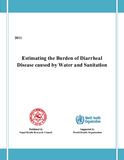Please use this identifier to cite or link to this item:
https://hdl.handle.net/20.500.14356/298Full metadata record
| DC Field | Value | Language |
|---|---|---|
| dc.contributor.author | Nepal Health Research Council (NHRC) | - |
| dc.date.accessioned | 2012-12-29T05:48:13Z | - |
| dc.date.accessioned | 2022-11-08T10:14:16Z | - |
| dc.date.available | 2012-12-29T05:48:13Z | - |
| dc.date.available | 2022-11-08T10:14:16Z | - |
| dc.date.issued | 2011 | - |
| dc.identifier.uri | http://103.69.126.140:8080/handle/20.500.14356/298 | - |
| dc.description.abstract | There is direct relationship between human being, environment and health. The magnitude of health problem is increasing day by day due to various environmental risk factors. Diarrhea is the major health problem in most of the developing countries, and a major significant environment sensitive disease. It is estimated that about 94% of the diarrheal burden is attributable to environment, and is associated with risk factors such as unsafe drinking water, poor sanitation and hygiene. The purpose of this current study is to estimate and calculate scenario based diarrheal diseases burden related to water sanitation and hygiene. This was a cross sectional, descriptive and comparative study in which 360 households were selected from six different scenarios on the basis of water sources and availability of toilet from terai, hill and mountain regions. This study could not represent all geographical and ethnic community because it is conducted within limited district and small scale. The findings of the study are explained on the basis of different scenario. | en_US |
| dc.language.iso | en_US | en_US |
| dc.publisher | Nepal Health Research Council | en_US |
| dc.subject | Diarrheal Disease | en_US |
| dc.title | Estimating the Burden of Diarrheal Disease caused by Water and Sanitation | en_US |
| dc.type | Technical Report | en_US |
| Appears in Collections: | NHRC Research Report | |
Items in DSpace are protected by copyright, with all rights reserved, unless otherwise indicated.

